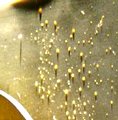
 |
Properties of selected saturated salt solutions |
| Salt/T | 5.0 | 10.0 | 15.0 | 20.0 | 25.0 |
| Lithium chloride | 11.3 | 11.3 | 11.3 | 11.3 | 11.3 |
| Magnesium chloride | 33.6 | 33.5 | 33.3 | 33.1 | 32.8 |
| Potassium carbonate | 43.1 | 43.1 | 43.1 | 43.2 | 43.2 |
| Sodium bromide | 63.5 | 62.2 | 60.7 | 59.1 | 57.6 |
| Sodium chloride | 75.7 | 75.7 | 75.6 | 75.7 | 75.3 |
| Potassium chloride | 87.7 | 86.8 | 85.9 | 85.1 | 84.3 |
| Potassium sulphate | 98.5 | 98.2 | 97.9 | 97.6 | 97.3 |
Baked molecular sieve with 3 micron holes is good and clean but its water content cannot be judged.
Baked calcium chloride is a widely used desiccant. An indicator is sometimes added to the salt when it is sold specially for use as a drying agent. It changes colour at too high an RH for calibration purposes.
Anhydrous copper sulfate is very good, and reusable by baking to a grey colour. It remains solid on absorption of water because it recrystallises to the monohydrate.
All these desiccants can be regenerated by heating at 150C.
Phosphorus pentoxide comes closest to ensuring absolute dryness, but it rapidly acquires a syrupy surface film which prevents further absorption of water vapour. It is also very corrosive and nasty to handle. Not recommended for general use.
The dry salt is spread about 3 mm deep in a shallow tray that occupies most of the bottom of an airtight box. Water is added to moisten the salt. Do not add more water than is needed to make the salt look damp. The instrument is then laid on a grid supported above the tray. Electronic sensors can be inserted through a hole in the box which is made reasonably airtight with a split rubber bung. Allow one hour for equilibration when the instrument is bulky. 20 minutes for small sensors.
Note that saturated salts that have equilibrium RH below ambient will continue to absorb water indefinitely and overflow. The 98% RH calibration can only be done in a room with constant temperature.

This work is licensed under a Creative Commons Attribution-Noncommercial-No Derivative Works 3.0 License.